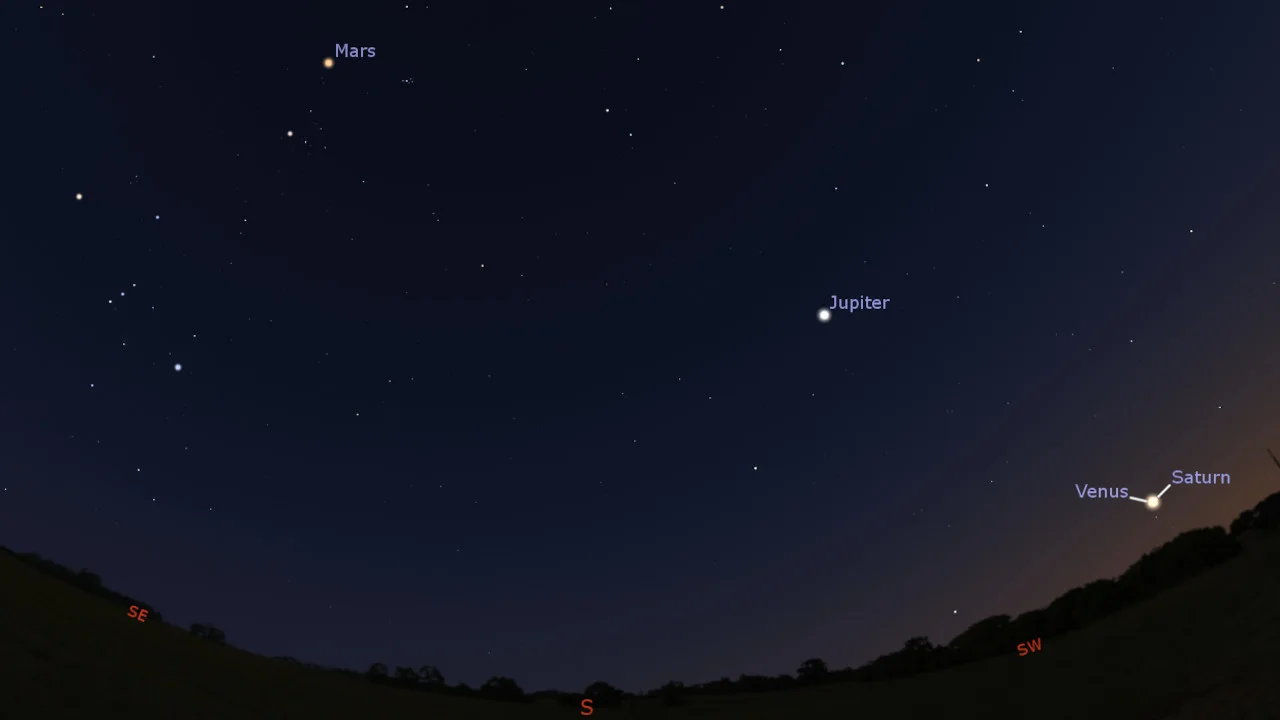
Bright 'evening star' Venus dazzles this winter in two planetary conjunctions
Plus watch for a lineup of planets across the sky each night, and possibly some surprises from the Ursid meteor shower to kick off the season.
With its long nights and still air, Winter is an excellent time for stargazing, planet viewing, and meteor watching. The planets are expected to perform an outstanding show, stretching across the night sky and forming bright conjunctions throughout the season.
Here's what to look for in the night sky for Winter 2022-2023.
Winter Astronomy at a glance
Dec 21: Winter Solstice (Northern Hemisphere)
Dec 21: Mercury highest above the eastern horizon after sunset
Dec 21-22: Peak of the Ursids meteor shower
Jan 3-4: Peak of the Quadrantids (best winter meteor shower)
Jan 4: Earth at Perihelion (closest to the Sun for 2023)
Jan 6: Full Wolf Moon
Jan 22: Venus-Saturn Conjunction
Jan 26-Feb 9: Comet C/2022 E3 (ZTF) visible in northern sky
Jan 30: Mercury highest in the eastern sky before sunrise
Jan 30: Moon and Mars appear close enough to nearly touch
Feb 5: Full Snow Moon
Mar 1: Venus-Jupiter Conjunction
Mar 7: Full Worm Moon
Mar 20: Spring Equinox (Northern Hemisphere)
Visit our Complete Guide to Winter 2023 for an in-depth look at the Winter Forecast, tips to plan for it, and much more!
Solstice
On December 21, at 4:48 p.m. EST, the Sun will reach its southernmost point in the skies of Earth. In the northern hemisphere, this will mean the Sun will reach its lowest point in our sky, marking the first day of Winter. It will reach its highest point in the southern hemisphere, signalling the start of Summer.
This will be the shortest day of the year and, thus, the longest night.
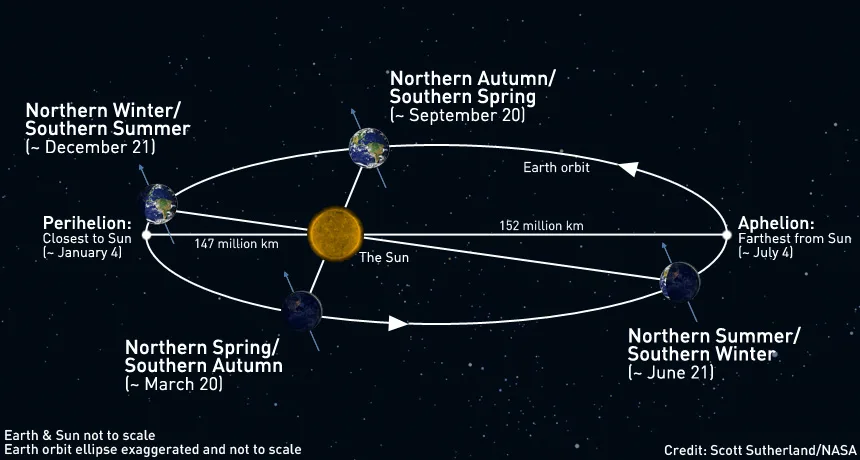
How much daylight and nighttime you see depends on how far north you live.
Kingsville, Ont (the southernmost community in Canada) will see 9 hours, 06 minutes and 43 seconds of sunlight on December 21. Meanwhile, Iqaluit, NU, will have less than half that, with only 4 hours, 20 minutes and 8 seconds of daylight. Farther north, the Sun will have already set for the last time this year and will only rise again in early 2023.
Meteor Showers
Look up any night, and you may spot a meteor zipping through the sky above. There are certain times of the year, however, when we can typically count on seeing several meteors streak overhead, all appearing to originate from the same region of the sky. We call these meteor showers, and two occur during winter — the Ursids and the Quadrantids.
The Ursids
On the night of the solstice, December 21-22, the Ursid meteor shower reaches its peak. This year's peak is well-timed to take place during the New Moon, so there won't be any significant sources of light in the sky to compete with. In most years, the Ursids only produce around 10 meteors per hour. However, we may see some extra activity during this year's peak, specifically on the morning of the 22nd.
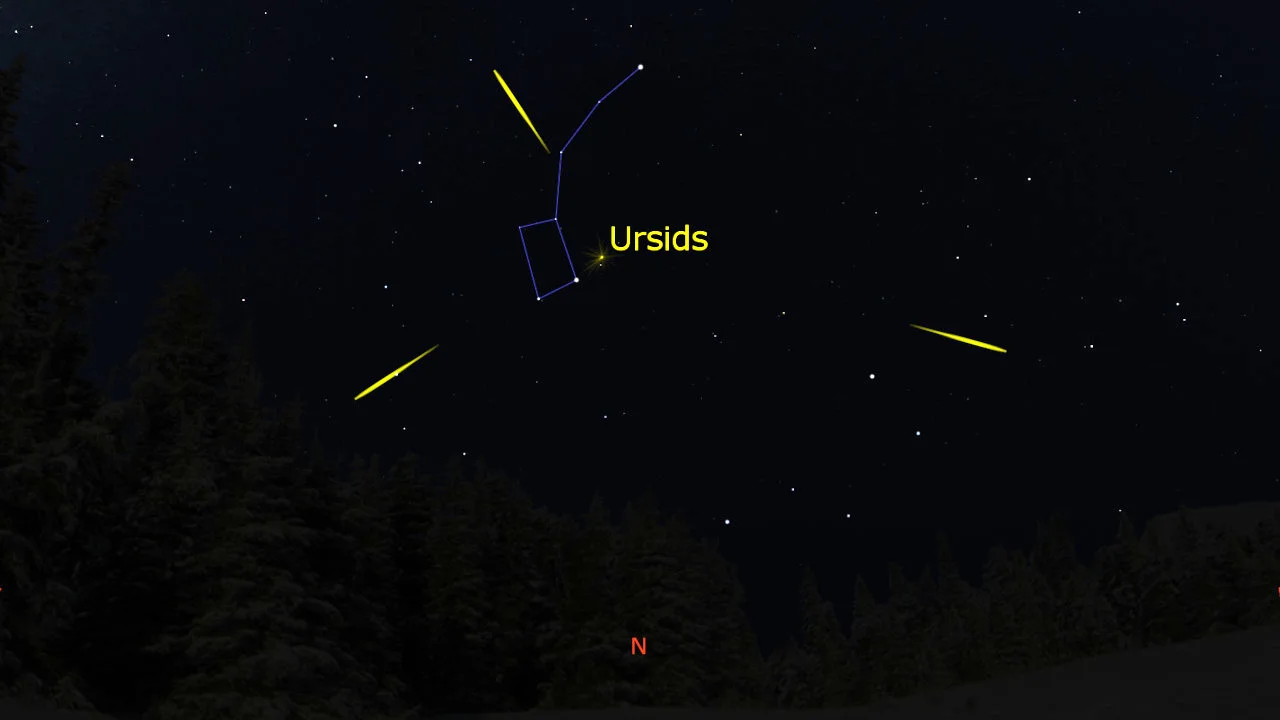
The Ursid meteor shower is named due to its radiant being positioned close to the constellation Ursa Minor, aka The Little Dipper. Credit: Stellarium/Scott Sutherland
According to the International Meteor Organization, NASA scientist Peter Jenniskens predicted a 'filament encounter' at around 10:22 UTC on December 22. During this event, Earth is expected to pass through a concentration of debris in the Ursid stream.
Jenniskens' research suggests that the number of meteors seen could jump to more than double the standard rate around that time. For viewers across Canada, this is timed for 6:52 a.m. NST, 6:22 a.m. AST, 5:22 a.m. EST, 4:22 a.m. CST, 3:22 a.m. MST, and 2:22 a.m. PST.
Another potential outburst was identified by Japanese meteor expert Mikiya Sato. According to his calculations, Earth may pass through a dust trail ejected from comet 8P/Tuttle (the source of the Ursids) back in the year 843.
While it has yet to be determined exactly how many meteors will be produced by this dust trail, Sato's timing for the event puts it at 14:22 UTC. That means it is well-timed for the western half of Canada. In Saskatchewan, morning twilight will have begun by this time, making viewing more challenging. However, the skies should still be dark in Alberta and British Columbia.
Both of these potential outbursts give one specific time, and while Earth moves through these concentrations of comet debris fairly quickly, give yourself a buffer of about 30 minutes before and after to be sure.
The Quadrantids
The best meteor shower of winter and one of the three best meteor showers of the year, the Quadrantids peak on the night of January 3-4.
The timing could be better, given that this is just three nights before the Full Moon. However, the placement of this shower's radiant in the northern sky will help viewers get the most out of the event.
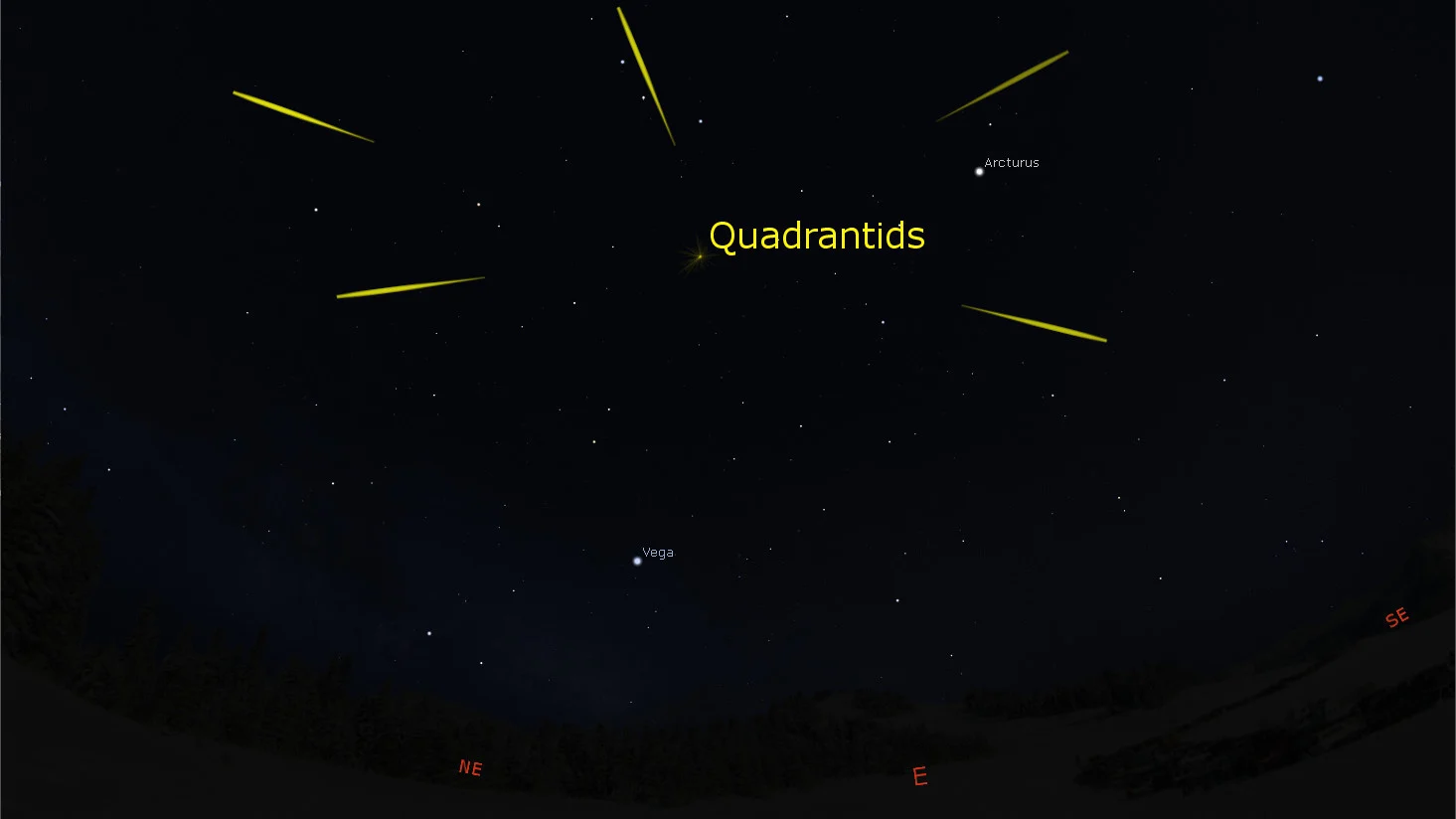
The radiant of the Quadrantids, in the NE sky, in the hours before dawn on the night of January 3-4, 2023. Credit: Stellarium/Scott Sutherland
While most meteor showers are produced by comets, Quadrantid meteors originate from 2003 EH1, an asteroid that may be an 'extinct comet' that has lost all of its ice. This puts the Quadrandits in an exclusive club, along with the Geminids, which come from 'rock comet' 3200 Phaethon, and the Northern Taurids, which originate from asteroid 2004 TG10 (which may, itself, be a piece of a shattered comet)!
The meteor shower 'radiant' for the Quadrantids (the point in the sky from which the meteors appear to radiate) never sets below the horizon. Thus, viewers only need to wait for the sky to be dark enough to spot meteors. With the bright Gibbous Moon shining during the peak, the best time to watch is in the hours just before sunrise on the 4th. That will put the Moon near the western horizon and the meteor shower radiant higher in the sky, providing better viewing conditions.
The exact number of meteors from the Quadrantids can vary from year to year. Typically, it produces around 120 per hour, which amounts to about two every minute.
Meteors from this shower can show up at any point in the sky above, but viewers should keep their back to the Moon to limit the amount of light they are exposed to.
Be sure to check out our guide to meteor shower watching at the bottom of the article.
Earth at perihelion
This event isn't so much something to see as it is something to experience.
Each year in early January, Earth reaches a point in its elliptical orbit known as perihelion — the planet's closest distance to the Sun for the entire year.
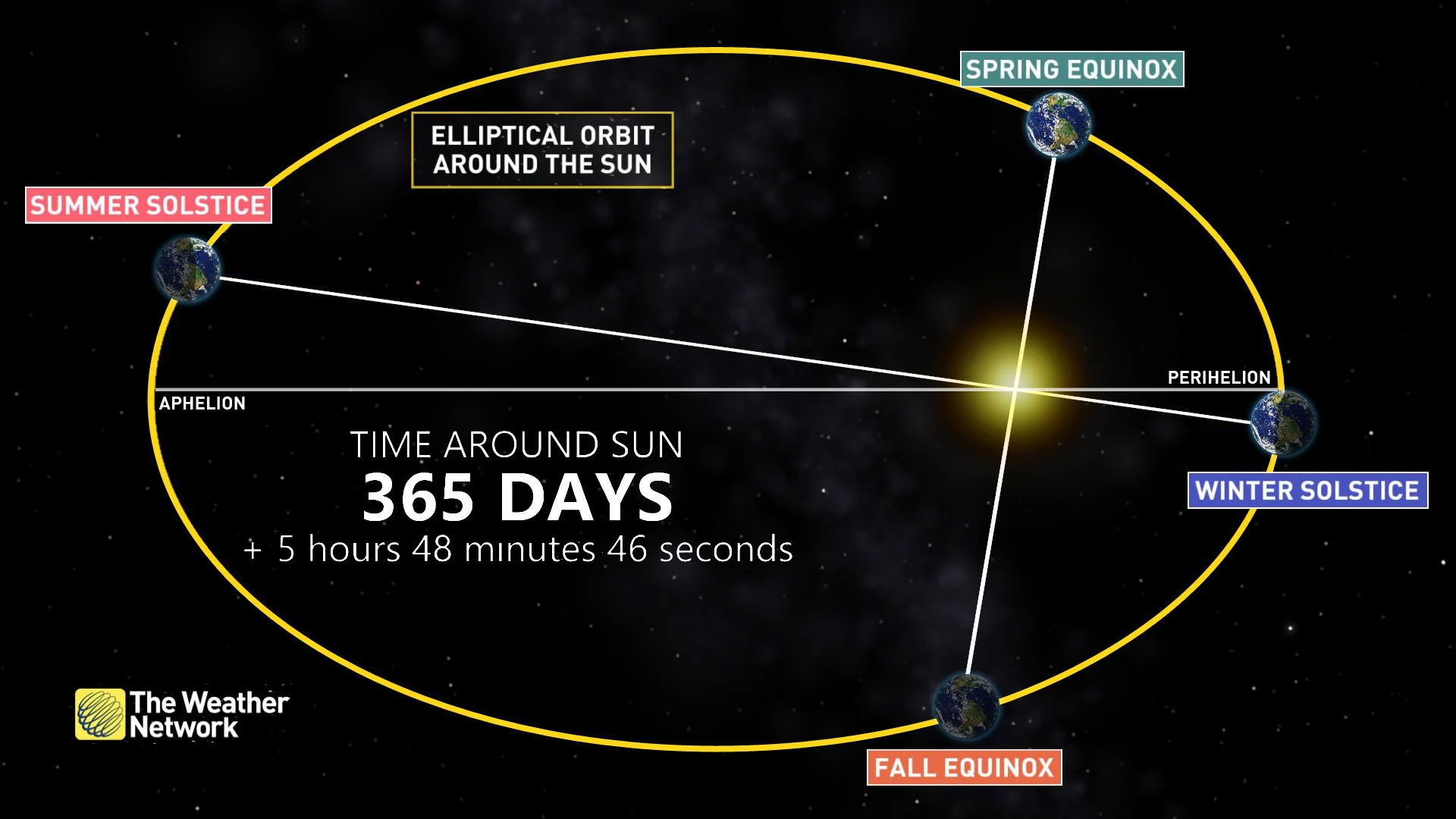
Earth's orbit around the Sun, noting the Solstices, Equinoxes and the timing of perihelion and aphelion. The image is not to scale, and the ellipse of Earth's orbit has been exaggerated. Credit: NASA/Scott Sutherland
If you want to mark the event, even if it's just to pause for a short break, it occurs at exactly 16:17 a.m. GMT on January 4, 2022. For those of us in Canada, that translates to:
12:47 p.m. January 4 NST
12:17 p.m. January 4 AST
11:17 a.m. January 4 EST
10:17 a.m. January 4 CST
9:17 a.m. January 4 MST
18:17 a.m. January 4 PST
According to retired NASA scientist Fred Espenak, at that exact moment, Earth will be 147,098,928 kilometres away from the Sun.
Will you feel anything when this occurs? Not specifically from the astronomical event, but it will still be cool to mark the moment when it happens!
The Moon
As there are in most seasons, we will see three Full Moons in Winter 2022-2023. The Full Wolf Micromoon is on January 6, the Full Snow Apogee Micromoon is on February 5, and the Full Worm Moon is on March 7.

The 13 Full Moons of 2023, including their popular names and any other notable facts — supermoons, micromoons, lunar eclipses, etc. Credit: Scott Sutherland/NASA GSFC, with data from Fred Espenak.
We've often heard of supermoons. These bigger and brighter Full Moons occur when the Moon is near the closest approach to Earth (aka perigee) in its elliptical orbit. The closest of these is known as the Perigee Supermoon. A micromoon is the opposite. It's a Full Moon that occurs when the Moon is close to apogee, its farthest distance from Earth. The most distant of these is called the Apogee Micromoon.
The Moon will be 405,789 km away from Earth during the January 6th Full Wolf Moon. That's only around 670 km from its maximum distance for the month, making it a micromoon.
The February 5 Full Snow Moon will be even farther away, at 405,830 km. That is just 645 km away from its total apogee distance. As the farthest Full Moon of the entire year and the closest to apogee, that makes it the Apogee Micromoon for 2023.
Since the Moon's elliptical orbit isn't static around Earth, by the time the March 7 Full Worm Moon comes around, it will have drawn closer to a little over 400,400 km away. That's over 5,800 km away from its apogee for the month, so this will be a standard Full Moon.
The Planets
Some of the brightest planets remain stretched across the night sky during this winter. Just after sunset, a quick scan across the clear night sky will yield Saturn in the southwest, Jupiter directly to the south, and Mars to the southeast.

The lineup of planets just after sunset on the night of Dec 21, 2022. Credit: Stellarium
Just as the season starts, look to the southwest just as the Sun is setting for a chance to see Mercury at its "greatest eastern elongation" (or farthest distance above the western horizon). Venus will also be above the horizon at that time. Still, it quickly sets and may not be visible when the other planets emerge from twilight. However, watch for Venus to climb progressively higher on the nights following.
Venus puts on a great show throughout the entire season, actually. Keep an eye on the western horizon each night after sunset for a week starting on January 15. Venus will climb away from the horizon and get closer and closer to Saturn until they appear to touch during the January 22 Venus-Saturn Conjunction! Repeat this process during the last week of February, leading up to the Venus-Jupiter Conjunction on the night of March 1.

Two Venus conjunctions occur this winter season, first with Saturn on Jan 22, and then with Jupiter on Mar 1. Credit: Stellarium/Scott Sutherland
In between those events, there are a few things to watch for.
Around midnight on the night of January 30-31, the Waxing Gibbous Moon will pass extremely close to Mars in our sky. To observers in the southern United States, Mexico, Central America and northern South America, the Moon will actually pass in front of the Red Planet, completely blocking it from view for a short period of time. Here in Canada, the two celestial objects will just be close enough in the sky that they will nearly touch.
Also, watch for Mercury to make another appearance at the end of January as it slips above the eastern horizon before sunrise. It will get higher and higher above the horizon each morning, leading up to the planet's "greatest western elongation" on January 30.
Don't miss!: How to see the rare green comet now swinging past Earth
Equinox
At precisely 21:25 GMT on March 20, the Sun will appear to cross Earth's celestial equator, ushering in Spring in the northern hemisphere. In the southern hemisphere, this denotes the start of Fall.
Tips for meteor shower watching
Meteor showers are events that nearly everyone can watch. No special equipment is required. In fact, binoculars and telescopes make it harder to see meteor showers, by restricting your field of view. However, there are a few things to keep in mind so you don't miss out on these amazing events.
The three best practices for observing the night sky are:
Check the weather,
Get away from light pollution, and
Be patient.
Clear skies are essential. Even a few hours of cloudy skies can ruin your chances of watching an event such as a meteor shower. So, be sure to check The Weather Network on TV, on our website, or from our app, and look for my articles on our Space News page, just to be sure that you have the most up-to-date sky forecast.
Next, you need to get away from city light pollution. If you look up into the sky from home, what do you see? The Moon, a planet or two, perhaps a few bright stars such as Vega, Betelgeuse and Procyon, as well as some passing airliners? If so, there's too much light pollution in your area to get the most out of a meteor shower. You might catch an exceptionally bright fireball if one happens to fly past overhead, but that's likely all you'll see. So, to get the most out of your stargazing and meteor watching, get out of the city. The farther away you can get, the better.
Watch: What light pollution is doing to city views of the Milky Way
For most regions of Canada, getting out from under light pollution is simply a matter of driving outside of your city, town or village until a multitude of stars is visible above your head.
In some areas, especially in southern Ontario and along the St. Lawrence River, the concentration of light pollution is too high. Getting far enough outside of one city to escape its light pollution tends to put you under the light pollution dome of the next city over. The best options for getting away from light depend on your location. In southwestern Ontario and the Niagara Peninsula, the shores of Lake Erie can offer some excellent views. In the GTA and farther east, drive north and seek out the various Ontario provincial parks or Quebec provincial parks. Even if you're confined to the parking lot after hours, these are usually excellent locations from which to watch (and you don't run the risk of trespassing on someone's property).
If you can't get away, the suburbs can offer at least a slightly better view of the night sky. Here, the key is to limit the amount of direct light in your field of view. Dark backyards, sheltered from street lights by surrounding houses and trees, are your best haven. The video above provides a good example of viewing based on the concentration of light pollution in the sky. Also, check for dark sky preserves in your area.
When viewing a meteor shower, be mindful of the phase of the Moon. Meteor showers are typically at their best when viewed during the New Moon or Crescent Moon. However, a Gibbous or Full Moon can be bright enough to wash out all but the brightest meteors. Since we can't get away from the Moon, the best option is just to time your outing right, so the Moon has already set or is low in the sky. Also, you can angle your field of view to keep the Moon out of your direct line of sight. This will reduce its impact on your night vision and allow you to spot more meteors.
Once you've verified you have clear skies and you've limited your exposure to light pollution, this is where being patient comes in.
For best viewing, your eyes need some time to adapt to the dark. Give yourself at least 20 minutes, but 30-45 minutes is best for your eyes to adjust from being exposed to bright light.
Note that this, likely more than anything else, is the one thing that causes the most disappointment when it comes to watching a meteor shower.
If you step out into your backyard from a brightly lit home and looking up for a few minutes, you might be lucky enough to catch a rare bright fireball meteor. However, it's far more likely that you won't see anything at all. Meteors may be streaking overhead, but it takes time for our eyes to adjust, so that we can actually pick out those brief flashes of light. Waiting for at least twenty minutes, while avoiding sources of light during that time (streetlights, car headlights and interior lights, and smartphone and tablet screens) dramatically improves your chances of avoiding disappointment.
Sometimes, avoiding your smartphone or tablet isn't an option. In this case, set the display to reduce the amount of blue light it gives off and reduce the screen's brightness. That way, it will have less of an impact on your night vision.
You can certainly gaze into the starry sky while you are letting your eyes adjust. You may even see a few of the brighter meteors as your eyes become accustomed to the dark.
Once you're all set, just look straight up and enjoy the view!











